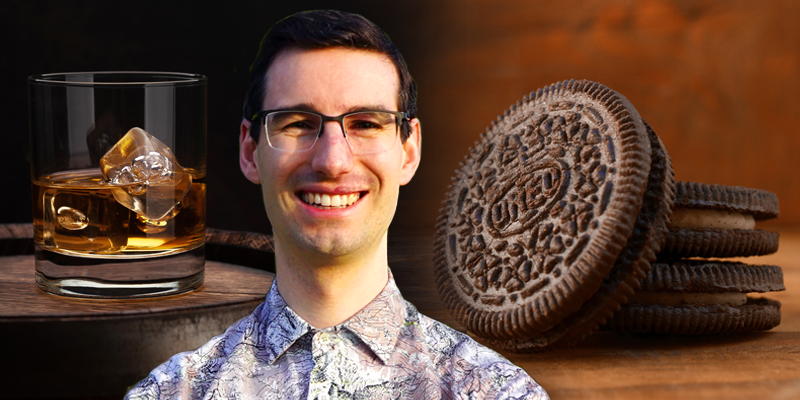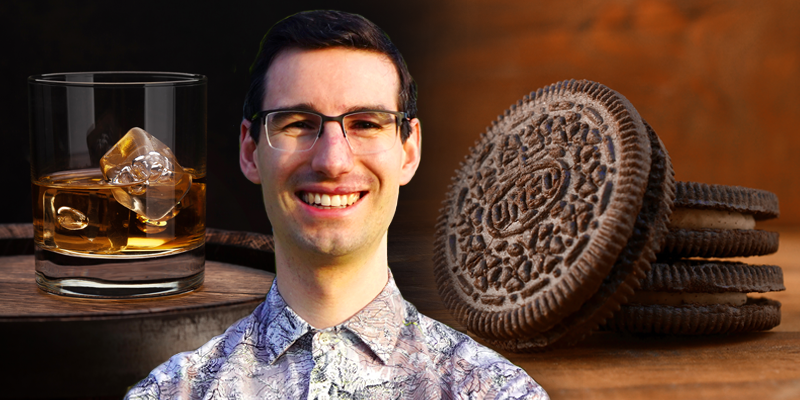From Whiskey to Oreos
Of all of Arnold Mathijssen’s high school teachers, he says it is his chemistry instructor that has had the biggest impact on his adult life. Not only did she convince him that physics rather than chemistry was his science, she also highlighted for him connections between the sciences that influenced how he approaches problems.
Early on in his career, Mathijssen drew on those connections in his work developing fluid-based models for understanding the impact of flows on the behaviors of pathogens and of various micrometer-sized robotic swimmers. But then the pandemic hit and he, like many scientists, found himself at home looking for new problems to tackle. That search led the University of Pennsylvania physicist to ditch the lab and head to the kitchen, at least for a time. “A few of us started chatting on Zoom about how we could continue our projects, and the kitchen seemed a natural venue to try out some things,” he says.
Mathijssen and his kitchen collaborators have now written a 77-page review of culinary-fluid problems that takes readers on a gastronomical adventure that starts with cocktails and ends with coffee, desserts, and dishwashing. Mathijssen spoke to Physics Magazine about his food-science exploits and about why food-related problems hit the spot when it comes to breaking down scientific silos and making science more diverse.
All interviews are edited for brevity and clarity.
What was the first food experiment you tried at home when the shutdowns happened?
It’s a little embarrassing to say, but it involved whiskey. If you drop water into a glass containing whiskey, these long filaments begin to form as the liquids mix. The filaments look like coiling snakes swimming through the whiskey, and they last for only a few seconds. The phenomenon is called awakening the serpent.
The patterns really caught our attention and we decided to study them systematically, using a thin, rectangular “glass” so that we could remove any distortions caused by the glass shape.
Why do these patterns form?
Alcohol and water are miscible liquids, which means that it is energetically favorable for the liquids to mix. That mixing can happen via two routes: either the molecules diffuse across the interface between the liquids until the system is homogeneous, or that interface deforms, stretching and folding until the liquids become one. The latter route leads to the formation of a snake-like pattern.
So how did you get from experimenting with whiskey and water to writing a full-blown review?
The kitchen is a natural venue for science because it’s accessible—everyone has a kitchen at home—and the tools and ingredients you need to do experiments are cheap and can be found in every grocery store. Initially, we thought we’d write a series of columns about different culinary-fluid problems. But one page became two, the column became a paper, and then it just totally got out of hand.
Your exploration of food-based problems touches on systems ranging from champagne to Cheerios and from ice cream to kitchen sinks. Which one was your favorite to dig into?
Coffee. The process of making coffee is rich in physics. First there is percolation, which involves water moving through a very densely packed bed of coffee grains. Then once the gaps are all filled with liquid, the problem becomes one of water flowing through a porous material.
Porous media flows were first described by the French physicist Henry Darcy in the 19th century when he was working on flows in fountains. At the time, fountains were a source of safe public drinking water, as the motion of the water helped stopped algae and bacteria from growing in the water supply. Darcy was looking at how water in aquifers that supplied the fountains moved through porous media. I was really fascinated with this connection between coffee and geological flows. Also, I’m addicted to coffee, so delving into the literature around coffee was a good excuse to make another cup.
Did the literature search throw up any surprises?
A little for coffee, but even more for tea. If you sprinkle a few tea leaves into a cup of water and then stir the water, the tea leaves will move inward, collecting at the center of the swirl. That’s the opposite to what you would expect from centrifugal physics, which predicts that in a spinning system the heavy particles—in this case the tea leaves—will get thrown outward.
Albert Einstein was the first person to put together a complete explanation of this “tea leaf effect,” which comes from a secondary flow in the cup that acts in the orthogonal direction to the swirls and pushes the leaves inward. Einstein then linked this effect to why rivers develop meandering paths—that is also from a secondary flow that erodes sand from one side of the river and deposits it on the other. So, like coffee, tea is related to processes that shape the landscapes that we live in.
Today it’s rare to find a scientist who works on problems in disparate fields—quantum physics, fluid dynamics, and geophysics. Why do you think that is?
I don’t know. How to approach studying science is very personal. Some people like to specialize and explore a topic in fine detail, but that means they can miss connections with problems outside of the specific one they are looking at. Others want to work more broadly.
I think both should be encouraged. We need a system of science that allows for different approaches and more diverse ways of doing science. That could also help a wider range of people think that science is for them.
I regularly go to schools in Philadelphia to engage children in science. One of my favorite experiments involves trying to twist Oreos. (You can’t when they are cold, but you can after you have held one between your hands for 60 seconds and the center cream has melted a little.) When I and others come with cookies, all the kids love it. Suddenly everyone in the room is on the same page. They all get curious and want to mess around with the cookies and understand the science. It’s wonderful to see.
–Katherine Wright
Katherine Wright is the Deputy Editor of Physics Magazine.





